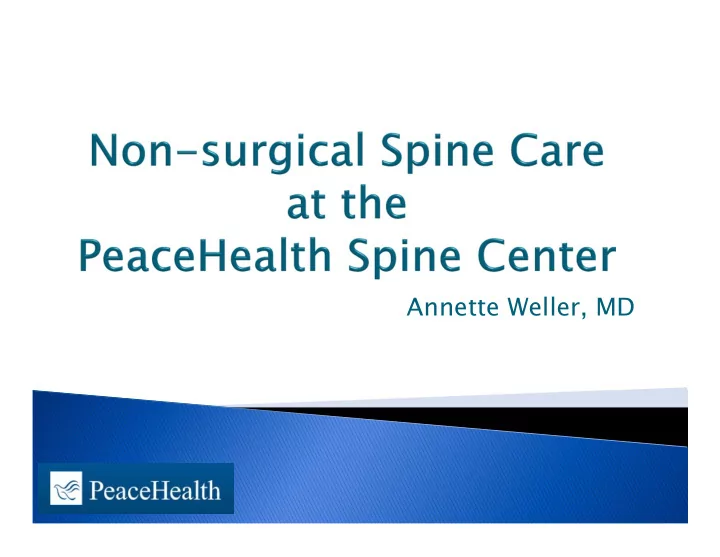

Annette Weller, MD
Next to the common cold, LBP is the 3 rd most common reason for physician office visits 1 Leading cause of disability under 45yo. 2 >26 million Americans between the ages of 20-64 experience frequent back pain 2 25% US Adults have back pain lasting >1 day in the past 3 months 3 1/3 with persistent pain 1yr after acute LBP Cost >$100,000,000,000/year 4 ◦ 2/3 of which are lost wages & productivity ( 1 CDC National Ambulatory Medical Care Survey 2010; 2 National Centers for Health Statistics, 2006; 3 Deyo et al, SPINE 2006; 4 Bureau of Labor Statistics 2008;)
Improved clinical outcomes & pt satisfaction through collaborative treatment Reduce progression to chronic pain Diminish burden on PCPs Reduce $ of care for back pain (Trillium RFP) ◦ ED visits ◦ Imaging ◦ Surgical Interventions
Nonsurgical first (unless red flags) Physiatry led / multi-disciplinary team Address Bio Psycho Social Model Shared decision making Patient focused/Patient friendly ◦ Patient navigator ◦ One-stop shopping Outcome data collection
Nonsurgical, Board Certified MD Physical Medicine Neuro-Musculoskeletal Training Neurology Non-surgical Orthopedic Rheumatology Rehab Medicine Focus on improving function Experience with multidisciplinary teams
Bio-psycho-social model
Nerve “Diskogenic” Muscles Facet joints Ligaments Bones Role of H&P
False positive rates high for disk herniation or other abnormalities 63% Asymptomatic have abnormal disks on lumbar MRI (Jensen et al, N Engl J Med 1994) 86% ♂ / 89% ♀ cervical discs abnormal >60yo (Matsumoto et al. J Bone Joint Surg [Br] 1998) Use concordant w/ pt pain pattern & neurologic deficit
MRI Complementary ◦ Evidence of nerve injury ◦ High specificity ◦ ID radiculopathy when normal MRI May differentiate peripheral nerve/root involvement ID other neurologic conditions that mimic radiculopathy
Depression ◦ pHQ9 Scale ◦ Waddell signs Anxiety/stress Pain avoidance behavior “Catastrophising”
Job Dissatisfaction Job Modifications Distress (MMPI) Enabled behavior for secondary gain Family Support / Influence to forced life- style changes
3,020 workers – 279 with low back pain Predictors: ◦ Job dissatisfaction “Hardly ever enjoyed work” were 2.5x more likely to report back injury ◦ MMPI Hysteria scale, highest 20% were 2.0x more likely to report back injury “Non-physical factors significantly impact the reporting of back injuries and may also affect patients’ response to medical treatment.” (Bigos et al. Clin Orthop Relat Res., 1992, A Longitudinal prospective study of industrial back injury reporting )
Bio ◦ H&P ◦ Imaging ◦ Nerve Conduction Studies/Electromyography ◦ Red flags/surgical indications Psycho ◦ Addressing non-organic findings ◦ Pain and its emotional component Social ◦ Job & workplace satisfaction ◦ Family dynamics
Medications Physical therapy “Movement is good” Address psych-social issues Nutritional counseling and smoking cessation Education Shared decision making Goal: Improve function/movement with less pain
Focused H&P to ID: ◦ Non-specific LBP ◦ LBP associated with radiculopathy or spinal stenosis ◦ LBP with another spinal cause Appropriate use of Diagnostic Imaging Pt education with evidence based information ◦ Encourage pt to remain active ◦ Provide information @ effective self care options Medications with proven benefit
Goals: ◦ Improved pt outcomes & increased pt satisfaction ◦ Reduced progression to chronic pain ◦ Reduced PCP burden ◦ Decreased cost Evidence from Priority Health Early anecdotes / case studies
Priority Health Insurance required pts w/ non- urgent spine surgical consultations to first have physiatrist consult (2007 – 2010) ◦ Imaging studies ⇩ 18% ◦ Referrals to surgeons more highly directed (surgeon referrals ⇩ 48% resulting in surgical procedures only ⇩ 29%) ◦ Pt satisfaction ⇧ through more involvement and fewer surgeries ◦ First year total spine care cost ⇩ 12.1% ($14M) (Avg surgical cost ⇧ 8% reflecting increased ratio of fusions to total spine surgeries) Fox J, et al. Spine 2013, The effect of required physiatrist lt ti t f b k i
Core staffing of: ◦ Physiatrist ◦ Therapist ◦ Care Coordinator Aligned Medical & Surgical Consultants Diagnostic Services Use of evidence based guidelines Pt/care provider shared decision making Collection & reporting of clinical outcomes
31yo ♂ , chronic LBP, sciatica 2 mo hx of LBP, L flank & abdominal pn with multiple ER visits MRI:
79yo ♀ , chronic LBP & prior disk injuries 1mo hx R post leg ache & R lateral hip/groin pn w/standing & walking PCP Ortho Spine Center Imaging:
31yo ♀ , LB and left leg pain x 6 mo Exam with intact strength/sensation, positive SLR on left Imaging:
Annette Weller, MD mprehensive Spine Center
Recommend
More recommend